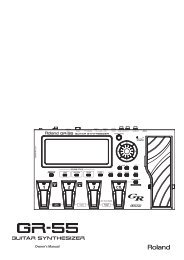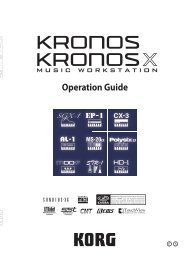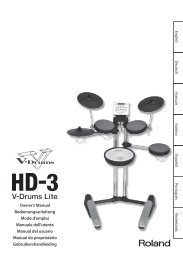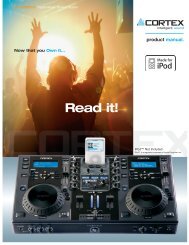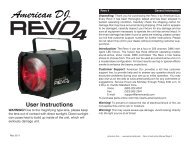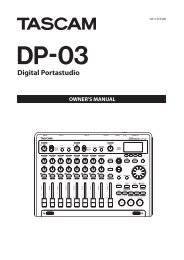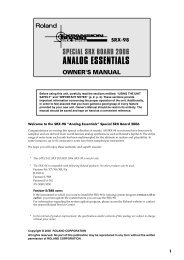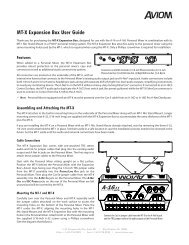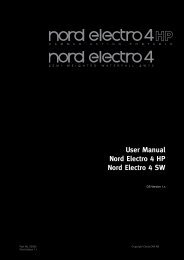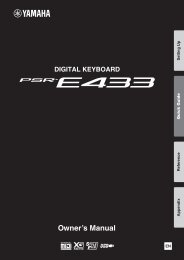Korg Microkorg Owner's Manual - zZounds.com
Korg Microkorg Owner's Manual - zZounds.com
Korg Microkorg Owner's Manual - zZounds.com
Create successful ePaper yourself
Turn your PDF publications into a flip-book with our unique Google optimized e-Paper software.
Messages transmitted and received by the microKORG<br />
• Modulation depth (CC#01) [Bn, 01, vv]<br />
When a modulation depth message is received, the LFO2 vibrato depth will change<br />
according to the value specified for PITCH "VIBRATO INT." If the value of the<br />
received message is the maximum value (127), vibrato will be applied over the full<br />
pitch range specified by "VIBRATO INT." If the value of the received message is 0, no<br />
vibrato will apply.<br />
When you move the microKORG's MOD wheel, modulation depth messages are<br />
transmitted on the MIDI channel ("MIDI CH").<br />
• Volume (CC#07) [Bn, 07, vv]<br />
If you assign control change (CC#07 – volume) to AMP "LEVEL," volume messages<br />
can be received to control the volume.<br />
• Panpot (CC#10) [Bn, 0A, vv]<br />
If you assign control change (CC#10 – pan) to AMP "PANPOT," pan messages can be<br />
received to control the stereo position of the sound.<br />
Assigning control changes to knobs and keys<br />
You can use the SHIFT function "CONTROL CHANGE" to assign a control change in the<br />
range of CC#00–CC#95 to principal parameters that corr espond to panel knobs and<br />
keys. When you operate the assigned knob or key, the corresponding control change will<br />
be transmitted. If the Performance Edit function is enabled, the control change for the<br />
corresponding parameter will be transmitted.<br />
When control changes are received from an external device, the microKORG will behave<br />
according to the value of the control change, just as when the corresponding knob or key<br />
is operated (➝p.56 "Control change assignments for the microKORG's knobs and keys").<br />
In addition, when you use the front panel TIMBRE SELECT key to switch timbres, a<br />
message (Timbre Select) indicating which timbre is selected will be transmitted. When<br />
the microKORG receives a Timbre Select message, it will switch timbres according to the<br />
value of the message. (0: Timbre 1, 1: Timbre 1&2 (Sync), 2–127: Timbre 2).<br />
You can use the SHIFT function "CONTROL CHANGE" TimbSelect to assign a control<br />
change to Timbre Select as well.<br />
Sync control<br />
The first-played note-on will sync a LFO whose "KEY SYNC" = Timbre( ).<br />
However in order to distinguish manually played note-on/off's from those that are<br />
repeated automatically by the arpeggiator, the microKORG's arpeggiator will transmit<br />
a Sync Control message at the time of note-on (when GLOBAL "POSITION" is Post<br />
KBD( )).<br />
A control change message is used for this Sync Control message as specified by Shift<br />
function "Control Change."<br />
By using Sync Control to apply sync to a LFO, you can cause each arpeggiated note to<br />
advance the random LFO by one step.<br />
Silencing all notes of a given channel<br />
• All note off (CC#123) [Bn, 7B, 00] (value is 00)<br />
When an All Note Off message is received, all currently-sounding notes of that<br />
channel will be turned off. Some sound may linger due to the envelope settings.<br />
• All sound off (CC#120) [Bn, 78, 00] (value is 00)<br />
When an All Sound Off message is received, all notes currently sounding on that<br />
channel will be silenced. While All Note Off allows the decay of a note to continue, the<br />
All Sound Off will silence the sound immediately.<br />
However, this message is intended for use in emergencies, and is not for use during a<br />
performance.<br />
Resetting all controllers of a given channel<br />
• Reset all controllers (CC#121) [Bn, 79, 00] (value is 00)<br />
When a Reset All Controllers message is received, all controller values currently<br />
operating on that channel will be reset. Some parameters assigned using Virtual Patch<br />
will not be reset.<br />
❏ Parameters transmitted and received via NRPN<br />
Front panel knobs and keys other than the controls listed above are assigned NRPN<br />
(Non Registered Parameter No.). NRPN messages can be used freely by any musical<br />
instrument manufacturer or model.<br />
NRPN editing is performed using the following procedure.<br />
1 Use NRPN MSB (CC#99) [Bn, 63, mm] and NRPN LSB (CC#98) [Bn, 62, rr] (n:<br />
channel, mm, rr: parameter no. upper and lower bytes) to select the parameter.<br />
2 Use data entry MSB (CC#6) [Bn, 06, mm] (n: channel, mm: parameter value) to specify<br />
the value.<br />
On the microKORG, only data entry MSB is used.<br />
Controlling the arpeggiator<br />
When arpeggiator settings are modified by the front panel keys or knobs, the following<br />
NRPN messages are transmitted. When these NRPN messages are received, the corresponding<br />
arpeggiator settings will change accordingly. These messages are transmitted<br />
and received on the MIDI channel(“MIDI CH”). For the correspondence between the<br />
values of the message and the values of the microKORG parameter, refer to the table.<br />
• ON/OFF: [Bn, 63, 00, Bn, 62, 02, Bn, 06, mm]<br />
• RANGE: [Bn, 63, 00, Bn, 62, 03, Bn, 06, mm]<br />
• LATCH: [Bn, 63, 00, Bn, 62, 04, Bn, 06, mm]<br />
• TYPE: [Bn, 63, 00, Bn, 62, 07, Bn, 06, mm]<br />
• GATE: [Bn, 63, 00, Bn, 62, 0A, Bn, 06, mm] (n: channel, mm: parameter value)<br />
53



